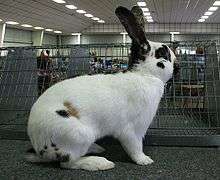Rhinelander rabbit


The Rhinelander rabbit is a medium-sized breed of European rabbit[1] from Germany. They are known for their distinctive facial "butterfly markings", generally of black and orange, on a white background. Initially developed in Germany in the first decade of the 20th century, they began to be exported to other countries in the 1920s. Although popular in Germany at first, interest in the breed dwindled by 1930 possibly due to an increase in popularity of the Checkered Giant; however, they experienced a resurgence in popularity after World War II. Interest also waxed and waned in the United States, where the breed experienced a 40-year absence between 1932 and 1972. Re-establishment in that country in the 1970s resulted in the creation of the Rhinelander Rabbit Club of America in 1974. Today, the world-wide population is estimated at less than 2,000 by the American Livestock Breeds Conservancy, and in Great Britain they are grouped with other rare rabbit breeds in the Rare Varieties Club.
Description
The Rhinelander is an arched breed of rabbit, meaning that light shows between the body and ground when the rabbit is sitting or moving. They have shorter legs and a less distinct arch than the similar Checkered Giant breed. The Rhinelander is a barrel- or cylindrical-shaped rabbit, with the body being the same width from shoulders to hip. Rhinelanders are known for their distinctive coat pattern.[2] British standards call for a weight of 6 to 10 lb (2.7 to 4.5 kg),[3] while the American registry prefers a weight of 7 to 9 pounds (3.2 to 4.1 kg).[4] The only color pattern recognized by the British Rabbit Council guidelines is a white base colour with black and yellow markings on the face and back. The breed is known for its "butterfly markings" which cover the nose and upper jaw in a shape resembling a butterfly.[3] The American Rabbit Breeders Association recognizes a blue and fawn spotting pattern on a white background, as well as the black and yellow pattern.[4]
History

The Rhinelander first appeared in shows in 1902 in Germany, after initially being bred in North Rhine-Westphalia. They were developed from a cross between a Harlequin buck and a gray doe of unknown breeding. A buck from the litter had the markings that the Rhinelander would come to be known for - black and orange in color, located on the chin, ears and "butterfly markings" in black on one side and orange on the other. Another cross was made between the Harlequin buck and a Checkered Giant doe, with the resulting litter producing a doe with the desired markings. The buck from the first litter and the doe from the second litter were mated, and does from the resulting litters were crossed with Harlequin bucks to create the Rhinelander breed. In 1905, a German breed standard was created,[4] and they were given the German name "Rheinishe Schecke". In 1924, the first rabbits were exported to the Netherlands and England. Although initially very popular, the initial interest soon dwindled, along with breeder numbers. Selective breeding for color markings, as required by the breed standard, was beyond the skill of many breeders; this, combined with the athletic, rather than meat-producing, conformation, resulted by 1930 in only a few breeders continuing to preserve the breed. Interest reemerged in post-World War II Germany, however, and population numbers again grew, with the Rhinelander becoming the most popular spotted breed in the country by 1978.[5]
After the first exports from Germany to the US in 1923, the Rhinelander was recognized as a breed in the US by the National Breeders and Fanciers Association. By 1932, however, none remained in the US, likely due either to the difficulties of meeting the breed standard or to greater breeder interest in the Checkered Giant rabbit.[5] In 1972, an American breeder visiting West Germany saw the breed at a show and returned to the US with four Rhinelanders. In 1974, the Rhinelander Rabbit Club of America was created, and in 1975, the breed was acknowledged by the American Rabbit Breeders Association.[4] Over the next two decades, additional animals were imported from the Netherlands and Germany to combat problems with inbreeding among the limited population in the US. Some breeders crossed Rhinelanders with Harlequin or Checkered Giant rabbits to improve the stock. In 1994, the American breed standard was rewritten and clarified, and interest in the breed continued to grow.[5]
The American Livestock Breeds Conservancy places the breed at "watch" status, meaning they have a global population of less than 2,000 and less than 200 registrations in the US each year.[6] The Rhinelander is recognized by the British Rabbit Council[7] and the American Rabbit Breeders Association.[8] In Britain, the Rhinelander is grouped with other rare rabbit breeds in the Rare Varieties Club.[7]
References
- ↑ "Domestic Variety Species Summary Page". Wildpro. Retrieved 2013-03-31.
- ↑ Adams, Martha. "Rhinelanders". Rhinelander Rabbit Club of America. Retrieved 2013-03-08.
- 1 2 "Rhinelander" (PDF). British Rabbit Council. Retrieved 2013-03-04.
- 1 2 3 4 "Rhinelander Rabbit". American Livestock Breeds Conservancy. Retrieved 2013-03-04.
- 1 2 3 Purpus, Joanne (September–October 2006). "History of the Rhinelander". American Livestock Breeds Conservancy News.
- ↑ "Conservation Priority Livestock Breeds 2012" (PDF). American Livestock Breeds Conservancy. Retrieved 2013-03-04.
- 1 2 "Breed Standards". British Rabbit Council. Retrieved 2013-03-04.
- ↑ "ARBA Recognized Breeds". American Rabbit Breeders Association. Retrieved 2013-03-04.